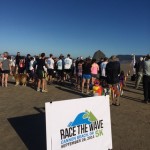

Tsunami racers, take your marks! This Sunday, September 13, Race the Wave participants will practice the tsunami evacuation route from the coast to higher ground in Cannon Beach, Oregon. We know that increasing preparedness levels across the board means greater community resilience, and Race the Wave is a great event to highlight during National Preparedness Month this September.
The race finishes at the higher ground of one of the community’s evacuation meeting points, where Cannon Beach will host a preparedness fair with interactive booths to learn more about how to prepare for emergencies and disasters.

Residents of Cannon Beach, Oregon gather for a 5K race following a tsunami evacuation route from the beach to a safe meeting spot. The race helped residents build the “muscle memory” of getting to safety, if they should feel an earthquake while they are on or near the beach.
Race the Wave uses the National Preparedness month themes of being disaster aware and taking action to prepare and makes those themes relevant for their community.
- Know the Plan: Make a plan with your family about where you will meet. Know if you need to pick your kids up from school. Know where you need to go and what to bring with you.
- Take the Route: Become familiar with signage in your area. Learn the evacuation route from where you live, work, and play. Evacuate on foot and avoid traveling by car if possible.
- Race the Wave: Natural warnings are the best sign of a tsunami. If you feel the ground shaking, move quickly inland or to a higher elevation. Listen to the radio to learn of tsunami warnings originating from non-local causes.
This is the second annual Race the Wave event, which includes a 10k, 5k and 2k for all abilities to participate in; participants can run, walk or roll the route. Visitors and locals alike will learn about the risks posed by the Cascadia Subduction Zone, and what they can do to stay safe.
The Community of Cannon Beach, Clatsop County Office of Emergency Management, Oregon Office of Emergency Management, Oregon Department of Geology and Mineral Industries (DOGAMI), Oregon Office on Disability & Health at Oregon Health & Science University and the Federal Emergency Management Agency (FEMA) Region X office are coming together to support Race the Wave.
FEMA encourages everyone to take steps to become better prepared for an emergency. Whether it’s at home, at work, at school, or in the community, there’s a lot that you can do to be ready and help others be ready too. This September, take time to get disaster prepared and take action to prepare.
What you can do:
- Register for the race
- Check out the event’s Facebook page & Twitter account
- Read about last year’s Race the Wave
Continue reading –
Know your tsunami evacuation routes – Race the Wave in Cannon Beach, OR Sept. 13


